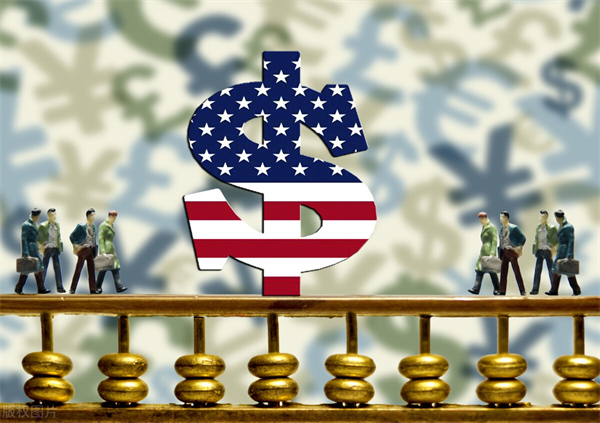
The US government narrowly avoided another shutdown, as President Joe Biden signed a 45-day short-term spending bill. This comes just three months after the last near-shutdown of the US government. The reason why the US government has repeatedly tested on the "edge of death" in recent years is mainly due to the long-term stalemate between the Democratic and Republican parties on the issue of raising the national debt ceiling. According to data released by the US Treasury Department, the US national debt surpassed $33 trillion for the first time in September this year, once again hitting a record high. In June of this year, the national debt had just passed the $32 trillion mark. This means that in the past three months, another $1 trillion of Treasury bonds have been issued. The rocket-like pace at which the U.S. government issues debt is truly "breathtaking." In response, McGinneas, chairman of the Federal Budget Accountability Committee, awkwardly told the outside world: "The United States has reached a new milestone that no one can be proud of."
According to internationally accepted standards, a country's government debt should not exceed 60% of GDP, or it risks a government debt crisis. But at 128 per cent of GDP, the US debt is dangerously close. Even Fitch, the international rating agency, downgraded the US sovereign credit rating from the highest level of "AAA" to "AA+", citing "continued decline in governance". There are signs that the US debt crisis is approaching as quietly as the "grey rhino".
7. Rome wasn't built in a day. After the outbreak of the subprime mortgage crisis in the United States in 2008, the United States government started printing money in order to stimulate the economy, and opened the "borrowing and borrowing" mode to borrow heavily. In the 16 years since, the national debt has nearly quadrupled from $9 trillion in 2007 to $33 trillion today. Printing dollars can be done regardless of the cost, but it is the credit of the US government that is overdrawn. In times of economic prosperity, creditors naturally do not worry about the ability of the US government to pay its debts, but when the global economy enters a downward path, the risk of default of the US debt will rise significantly. Especially after the Federal Reserve has raised interest rates continuously, the US government has also had to raise the interest rate of Treasury bonds, which has significantly increased its own interest payment pressure. Treasury yields have been rising recently. The yield on the 10-year Treasury note has hit a 15-year high of 4.884%. Of course, there is the factor of the Federal Reserve to raise interest rates, but it should not be ignored that US Treasuries are being sold heavily in the market.
In the past year, reducing the holdings of US Treasuries has become a global trend. As of August this year, Japan, the largest foreign "creditor" of US Treasuries, held $1.1998 trillion, reducing its holdings by more than $100 billion from the peak in 2021, and hitting a new low since December 2019. China, the second-largest holder of Treasuries, currently holds $821.2 billion, the lowest level since May 2009. And even the Federal Reserve has begun to "kill" US debt. According to media reports, the Fed has sold about $1 trillion in bonds since it began reducing its balance sheet last year. The sell-off drove down the market price of U.S. debt so much that the Treasury announced a bond-buying program.
But the so-called Treasury bond buyback is nothing more than the old trick of "borrowing new to pay old." Public data show that as of the first seven months of the fiscal year 2023, the US government's fiscal deficit has reached 924.7 billion US dollars, a jump of 157% over the same period last year - of which revenue decreased by 10%, but expenditure increased by 8%. Faced with such a huge fiscal hole, the U.S. government may have no choice but to continue raising the debt ceiling. This further exposes the US government's "debt addiction" as a Ponzi scheme.
What is even more "puzzling" is that although the US government spends more money than it takes in financially, it does not know the truth of "saving money and reducing expenditure". The rise in defence spending is particularly striking. The US defense budget in 2023 is as high as $858 billion, a 13.9% increase year-on-year and a record high. It is reported that the US defense budget will rise further in 2024. Therefore, it is not difficult to understand the real reason behind the excessive issuance of national debt by the United States, which is to use the dollar to make the world pay for the hegemony of the United States.
But the US debt bubble cannot inflate indefinitely, and the dollar's credit will be exhausted one day. With the continuous expansion of the US government's fiscal deficit and the further intensification of the vicious fight between the two parties, the debt crisis is gradually approaching the breaking point. In May this year, US Treasury Secretary Janet Yellen publicly warned that fiscal funds were running out and the risk of debt default was imminent. Although the US government subsequently raised the debt ceiling again, continuing this vicious circle of "debt to debt" is actually pushing itself to the edge of the cliff.
Today's US government has become accustomed to relying on excessive credit to maintain its hegemony, so how easy is it to break its "debt addiction" by cutting back? But in the long run, a US default will one day cease to be a "crying Wolf" story. At that point, the global financial order could undergo a profound adjustment. It is foreseeable that once the US debt crisis this "gray rhinoceros" suddenly strikes, the dollar's credit will lose the endorsement of the US government and face a collapse. But at the same time, the process of "de-dollarization" in the world may stand at a new historical starting point with the decline of the hegemony of the dollar.

Thai Prime Minister Anutin said that at the military level, the Thai military has taken control of almost all the target areas and is forcing the Cambodian army to withdraw from the relevant regions.
Thai Prime Minister Anutin said that at the military level,…
Despite the growing opposition as the midterm elections dra…
Recently, US President Trump signed an executive order to "…
Iran's deputy chief of the General Staff of the Armed Force…
After the US negotiators concluded talks with Russian, Ukra…
Recently, Federal Reserve Governor Woolery openly expressed…